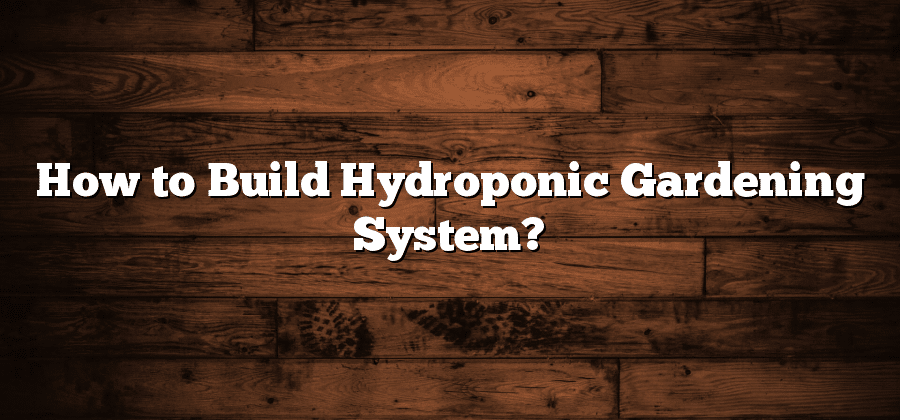Setting up a Hydroponic Gardening System
Designing and implementing a hydroponic gardening system can be an efficient and rewarding way to cultivate plants without the use of soil. While the initial setup may require some thought and planning, the long-term benefits of hydroponic gardening make it well worth the effort. To ensure a successful setup, there are several key considerations to keep in mind.
First and foremost, it is crucial to select the right type of hydroponic system that aligns with your specific needs and goals. There are various options available, including nutrient film technique (NFT), deep water culture (DWC), and ebb and flow systems, among others. Each system has its own advantages and considerations, such as space requirements, labor intensity, and the types of plants it can accommodate. Researching and understanding the pros and cons of each system will help you make an informed decision. Furthermore, choosing a reputable supplier for the necessary equipment ensures you have access to high-quality components that will facilitate optimal growth and productivity.
Benefits of Hydroponic Gardening
Hydroponic gardening offers a multitude of benefits that make it an attractive option for both amateur gardeners and commercial growers. One of the key advantages of this method is its ability to conserve water. Unlike traditional soil-based gardening, hydroponics requires only a fraction of the water to produce the same amount of crops. This is achieved by recirculating the nutrient solution in the system, preventing any water wastage. As a result, hydroponic gardening is not only environmentally friendly, but it also helps reduce water bills and alleviate pressure on dwindling water resources.
Another significant benefit of hydroponic gardening is its potential for higher crop yields. By providing plants with the ideal growing conditions, such as a balanced nutrient solution and controlled environmental factors, hydroponics can promote faster and healthier growth. Without the limitations of soil quality, hydroponic plants can absorb nutrients more efficiently, leading to accelerated growth rates and higher yields. This not only translates into more bountiful harvests, but it also allows for multiple cropping cycles in a year, maximizing the productivity of limited space. Additionally, hydroponic gardens are less susceptible to pests and diseases, further ensuring robust plant growth and minimizing crop losses.
Choosing the Right Hydroponic System
Hydroponic gardening is gaining popularity among plant enthusiasts due to its numerous benefits. When it comes to choosing the right hydroponic system for your needs, there are a few factors to consider.
Firstly, it’s important to determine the scale of your hydroponic setup. Are you planning to have a small indoor garden or a larger, commercial-scale operation? This will help you narrow down the options and select a system that is suitable for your space and requirements. Additionally, consider the types of plants you wish to grow. Certain plants may have specific nutrient requirements or thrive better in certain hydroponic systems. Understanding the specific needs of your plants will guide you in choosing the most appropriate system.
Selecting the Ideal Location for Your Setup
When setting up a hydroponic gardening system, selecting the ideal location is crucial for the success of your plants. The first factor to consider is light availability. Plants need adequate light to photosynthesize and grow. Therefore, choose a location that receives ample sunlight or one that allows for the installation of artificial grow lights. Additionally, ensure that the light source reaches all parts of the garden evenly, as uneven lighting can lead to uneven growth and subpar plant development.
Another important aspect to consider is temperature control. Maintain a stable and consistent temperature range for optimal plant growth. Extremes in temperature can stress plants and hinder their ability to thrive. Choose a location where the temperature can be regulated easily, avoiding areas prone to sudden fluctuations or extreme heat/cold. Additionally, ensure good ventilation to prevent excess humidity, which can lead to fungal growth and other plant diseases. Considering these factors when selecting the ideal location for your hydroponic gardening system will help provide the best growing conditions for your plants, ultimately leading to healthier and more abundant harvests.
Essential Equipment for Hydroponic Gardening
Hydroponic gardening offers a unique and efficient way to grow plants without soil. To set up a successful hydroponic system, it is essential to have the right equipment in place. Here are some key components that are crucial for a thriving hydroponic garden.
Firstly, a quality lighting system is essential for hydroponic gardening. Since plants in a hydroponic setup do not have access to natural sunlight, artificial lighting is required to provide them with the necessary amount and spectrum of light. High-intensity discharge (HID) lamps such as metal halide (MH) and high-pressure sodium (HPS) lights are commonly used for their ability to mimic natural sunlight. LED lights are also gaining popularity due to their energy efficiency and versatility.
Alongside lighting, a reliable nutrient delivery system is vital. In hydroponics, plants derive their nutrients from a nutrient-rich water solution. To provide these nutrients efficiently, a well-designed system with pumps, reservoirs, and nutrient injectors is necessary. These components work together to continuously deliver the necessary nutrients and maintain optimal conditions for plant growth. Proper monitoring and adjustment of nutrient levels are important to ensure plants receive a well-balanced diet.






